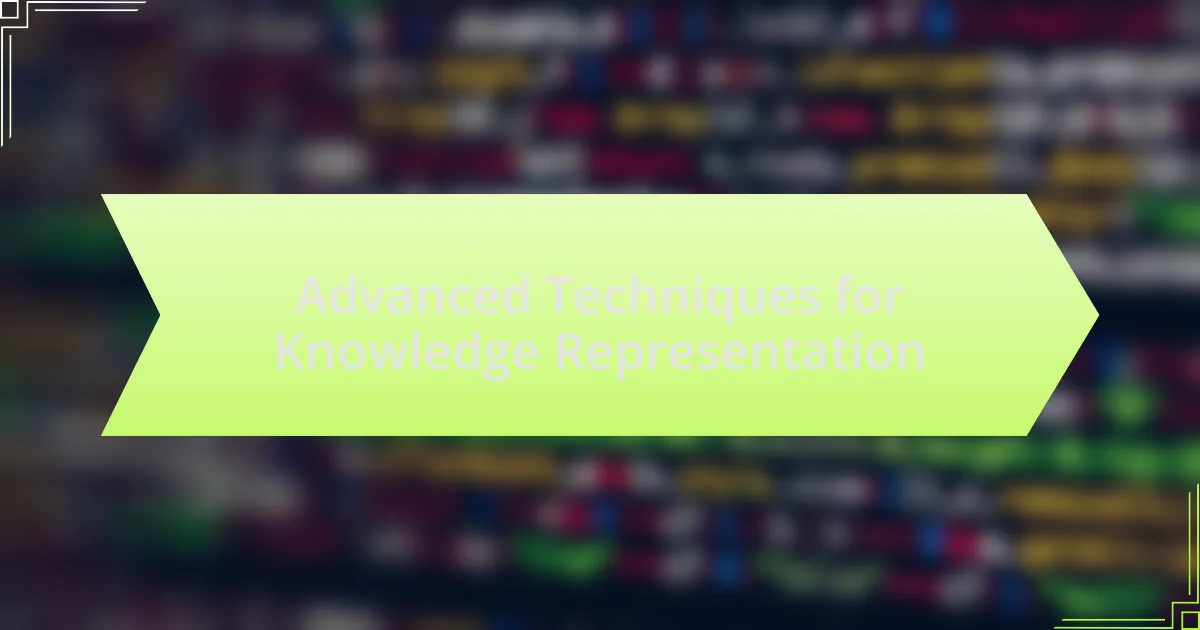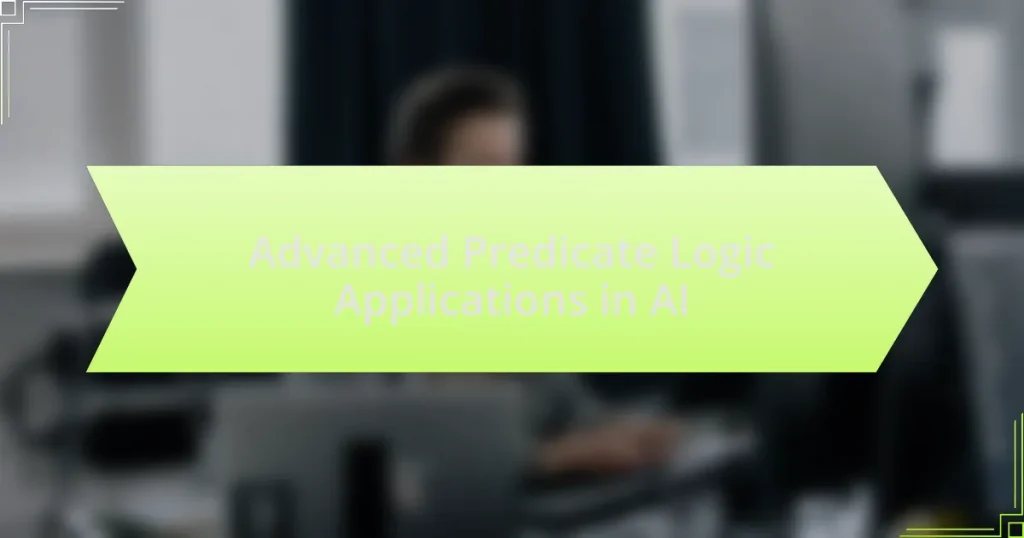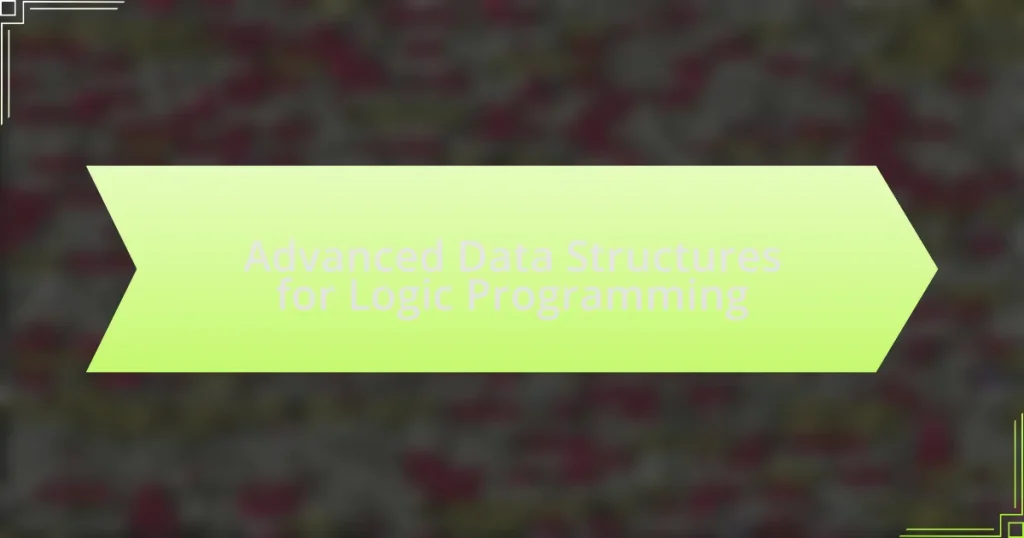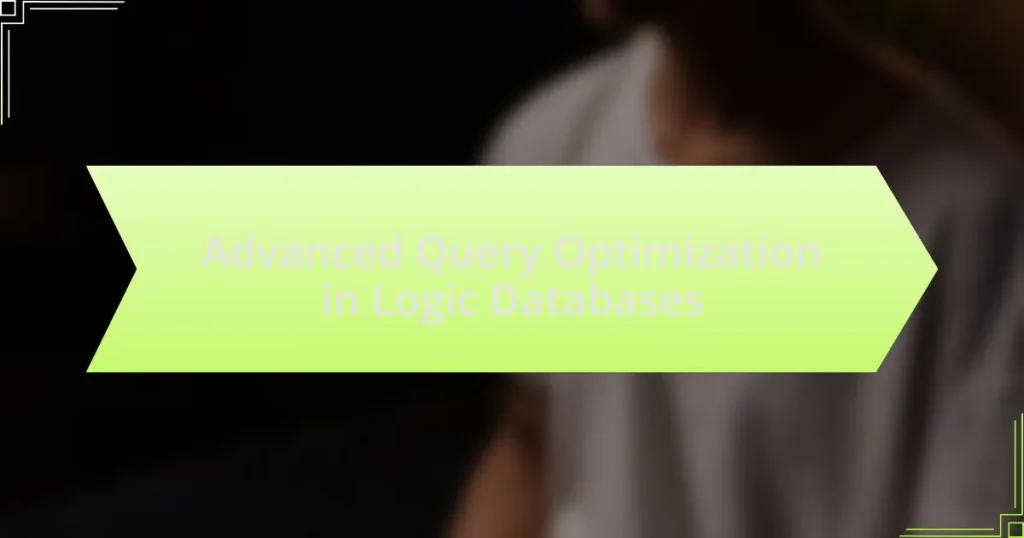Advanced techniques for knowledge representation encompass methods such as semantic networks, ontologies, frames, and rule-based systems, which enhance the modeling, sharing, and reasoning of knowledge in various applications, particularly in artificial intelligence and information systems. These techniques differ from traditional methods by effectively handling complex, unstructured data and providing dynamic, context-aware reasoning capabilities. The article explores the limitations of traditional knowledge representation methods, how advanced techniques address these challenges, and their significance in AI and machine learning. Additionally, it discusses the implementation of these techniques, the tools available, and future trends shaping knowledge representation.
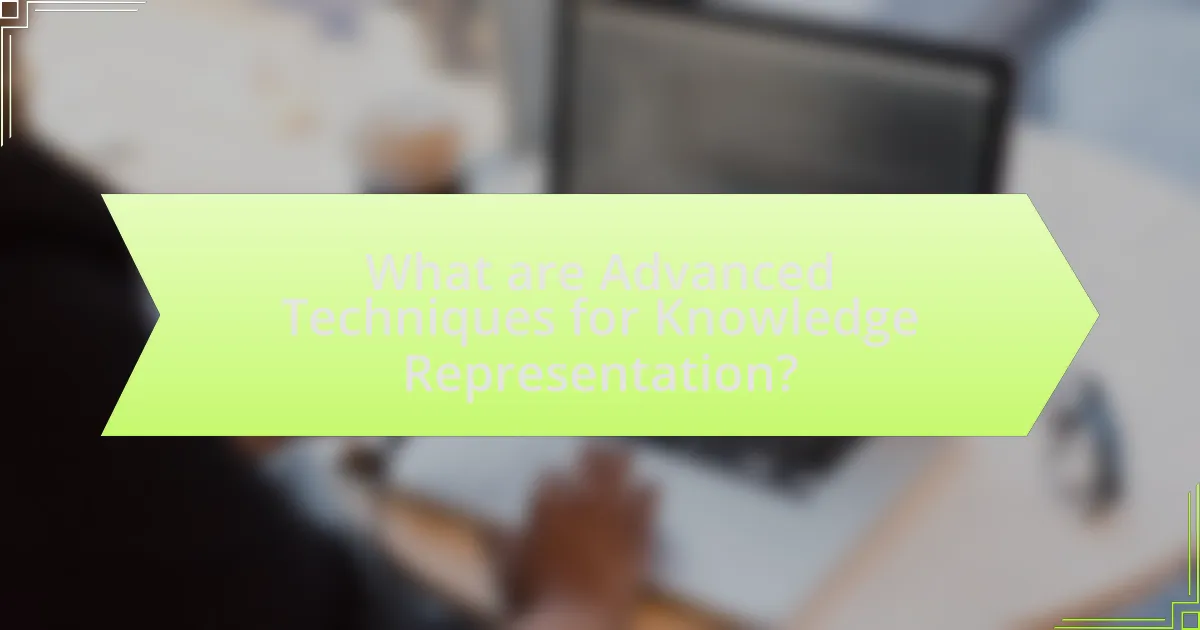
What are Advanced Techniques for Knowledge Representation?
Advanced techniques for knowledge representation include semantic networks, ontologies, frames, and rule-based systems. Semantic networks utilize graph structures to represent knowledge in terms of entities and their relationships, allowing for efficient information retrieval and inference. Ontologies provide a formal representation of a set of concepts within a domain and the relationships between those concepts, facilitating interoperability and shared understanding among systems. Frames are data structures that hold knowledge as attributes and values, enabling the organization of complex information in a way that mimics human cognitive structures. Rule-based systems use logical rules to represent knowledge and infer new information, making them effective for decision-making processes. These techniques enhance the ability to model, share, and reason about knowledge in various applications, including artificial intelligence and information systems.
How do these techniques differ from traditional methods?
Advanced techniques for knowledge representation differ from traditional methods primarily in their ability to handle complex, unstructured data and provide more dynamic, context-aware reasoning. Traditional methods often rely on rigid structures like frames or semantic networks, which can limit flexibility and adaptability. In contrast, advanced techniques such as ontologies and graph-based representations allow for richer relationships and more nuanced understanding of data, enabling systems to infer new knowledge and adapt to changing contexts. For example, ontologies facilitate interoperability between different systems by providing a shared vocabulary, which traditional methods lack, thus enhancing data integration and retrieval capabilities.
What are the limitations of traditional knowledge representation methods?
Traditional knowledge representation methods face several limitations, including their inability to effectively handle uncertainty and ambiguity in knowledge. These methods often rely on rigid structures, such as frames and semantic networks, which can struggle to represent complex relationships and dynamic information. For instance, traditional logic-based systems may fail to accommodate the nuances of human language and context, leading to incomplete or inaccurate representations. Additionally, they typically lack the flexibility to adapt to new information or evolving domains, which can hinder their applicability in real-world scenarios. This rigidity is evidenced by the challenges faced in natural language processing tasks, where traditional methods often fall short compared to more advanced techniques like neural networks that can learn from vast amounts of data and better capture the intricacies of knowledge.
How do advanced techniques address these limitations?
Advanced techniques address limitations in knowledge representation by employing methods such as ontologies, semantic networks, and deep learning models. These methods enhance the expressiveness and interoperability of knowledge systems, allowing for more accurate and context-aware representations of information. For instance, ontologies provide a structured framework that defines relationships between concepts, enabling better reasoning and inference capabilities. Semantic networks facilitate the representation of complex relationships, improving the ability to capture nuanced meanings. Additionally, deep learning models can process vast amounts of unstructured data, extracting relevant features and patterns that traditional methods may overlook. This integration of advanced techniques leads to improved accuracy, scalability, and adaptability in knowledge representation systems.
Why is knowledge representation important in artificial intelligence?
Knowledge representation is crucial in artificial intelligence because it enables machines to understand, reason, and utilize information effectively. By structuring knowledge in a way that computers can process, AI systems can perform tasks such as natural language understanding, problem-solving, and decision-making. For instance, semantic networks and ontologies are used to represent relationships between concepts, allowing AI to infer new knowledge and make connections that mimic human reasoning. This structured representation is essential for applications in areas like expert systems, where accurate knowledge retrieval and application are vital for performance and reliability.
What role does knowledge representation play in machine learning?
Knowledge representation is crucial in machine learning as it enables the encoding of information in a structured format that algorithms can process. This structured representation allows machine learning models to understand, reason, and make predictions based on the data. For instance, knowledge graphs and ontologies provide a way to represent relationships between concepts, facilitating better data integration and inference. Research has shown that effective knowledge representation can significantly enhance the performance of machine learning systems, as evidenced by studies demonstrating improved accuracy in tasks such as natural language processing and computer vision when utilizing structured knowledge.
How does effective knowledge representation enhance decision-making?
Effective knowledge representation enhances decision-making by providing structured and accessible information that facilitates analysis and understanding. When knowledge is represented clearly, decision-makers can quickly identify relevant data, relationships, and patterns, leading to more informed choices. For instance, research by R. A. Brachman and H. J. Levesque in “Knowledge Representation and Reasoning” highlights that well-organized knowledge bases improve the efficiency of reasoning processes, allowing for quicker evaluations of alternatives and outcomes. This structured approach reduces cognitive load and minimizes errors, ultimately leading to better decision quality.
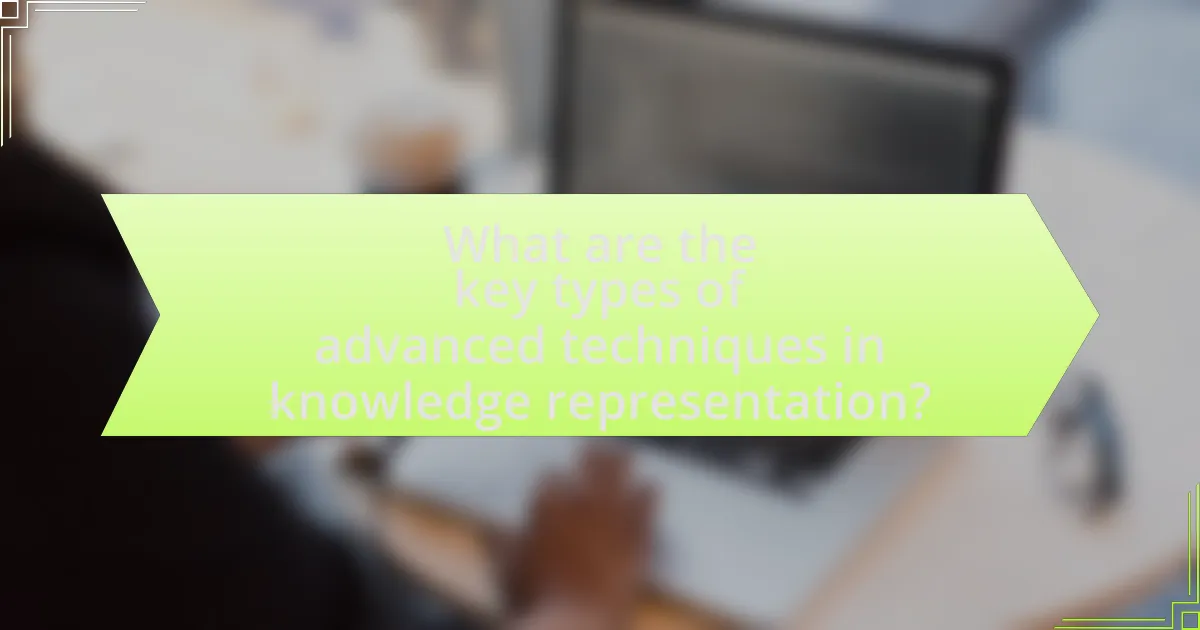
What are the key types of advanced techniques in knowledge representation?
The key types of advanced techniques in knowledge representation include semantic networks, frames, ontologies, and rule-based systems. Semantic networks represent knowledge in a graph structure, where nodes denote concepts and edges represent relationships, facilitating the understanding of complex interrelations. Frames provide a structured way to represent stereotypical situations, encapsulating attributes and values, which aids in organizing knowledge efficiently. Ontologies define a set of concepts and categories in a specific domain, along with the relationships between them, enabling shared understanding and interoperability among systems. Rule-based systems utilize a set of “if-then” rules to infer new knowledge from existing information, allowing for dynamic reasoning and decision-making. These techniques enhance the ability to model, reason, and manipulate knowledge effectively in various applications.
What is ontological representation and how is it used?
Ontological representation is a formal way to describe the entities, concepts, and relationships within a specific domain, enabling a shared understanding among systems and users. It is used in various fields such as artificial intelligence, semantic web, and information retrieval to facilitate knowledge sharing, interoperability, and reasoning. For instance, ontologies like OWL (Web Ontology Language) allow for the creation of rich, machine-readable definitions of concepts, which can be utilized in applications such as natural language processing and data integration, enhancing the ability to infer new knowledge from existing information.
What are the components of an ontology?
The components of an ontology include classes, properties, instances, and relationships. Classes represent the categories or types of entities within the domain, while properties define attributes or characteristics of those classes. Instances are the specific occurrences of classes, and relationships describe how instances and classes interact with one another. These components work together to create a structured framework for knowledge representation, enabling effective data organization and retrieval.
How do ontologies facilitate knowledge sharing?
Ontologies facilitate knowledge sharing by providing a structured framework for representing and organizing information, enabling different systems and users to understand and interpret data consistently. This structured representation includes defined concepts, relationships, and categories that standardize terminology across various domains, reducing ambiguity and enhancing interoperability. For instance, in the biomedical field, ontologies like the Gene Ontology standardize the representation of gene functions, allowing researchers from different institutions to share and integrate their findings effectively. This standardization is crucial for collaborative research and data integration, as it ensures that all parties have a common understanding of the terms and concepts being used.
What are semantic networks and their applications?
Semantic networks are graphical representations of knowledge that depict relationships between concepts through nodes and edges. They are used in various applications, including natural language processing, information retrieval, and artificial intelligence, to facilitate understanding and reasoning about information. For instance, semantic networks enable systems to infer relationships and meanings, enhancing tasks such as question answering and semantic search. Their effectiveness is supported by their ability to model complex relationships, as demonstrated in research by Quillian (1966), which illustrated how semantic networks can represent hierarchical relationships in human memory.
How do semantic networks represent relationships between concepts?
Semantic networks represent relationships between concepts through nodes and edges, where nodes symbolize concepts and edges denote the relationships connecting them. This structure allows for the visualization of how concepts are interrelated, such as hierarchical relationships (e.g., “is a” or “part of”) and associative relationships (e.g., “related to”). For instance, in a semantic network, the concept “dog” may be linked to “animal” with an “is a” edge, indicating that a dog is a type of animal. This representation facilitates reasoning and inference, as it enables the extraction of knowledge based on the connections between concepts.
What are the advantages of using semantic networks in knowledge representation?
Semantic networks offer several advantages in knowledge representation, including enhanced clarity, efficient information retrieval, and the ability to represent complex relationships. These networks visually depict relationships between concepts, making it easier for users to understand and navigate the information. Additionally, semantic networks facilitate quick access to related information through their interconnected structure, which allows for efficient querying and data retrieval. Research indicates that semantic networks can effectively model intricate relationships, such as hierarchies and associations, which traditional data structures may struggle to represent accurately. This capability supports more sophisticated reasoning and inference processes, ultimately improving the overall effectiveness of knowledge representation systems.
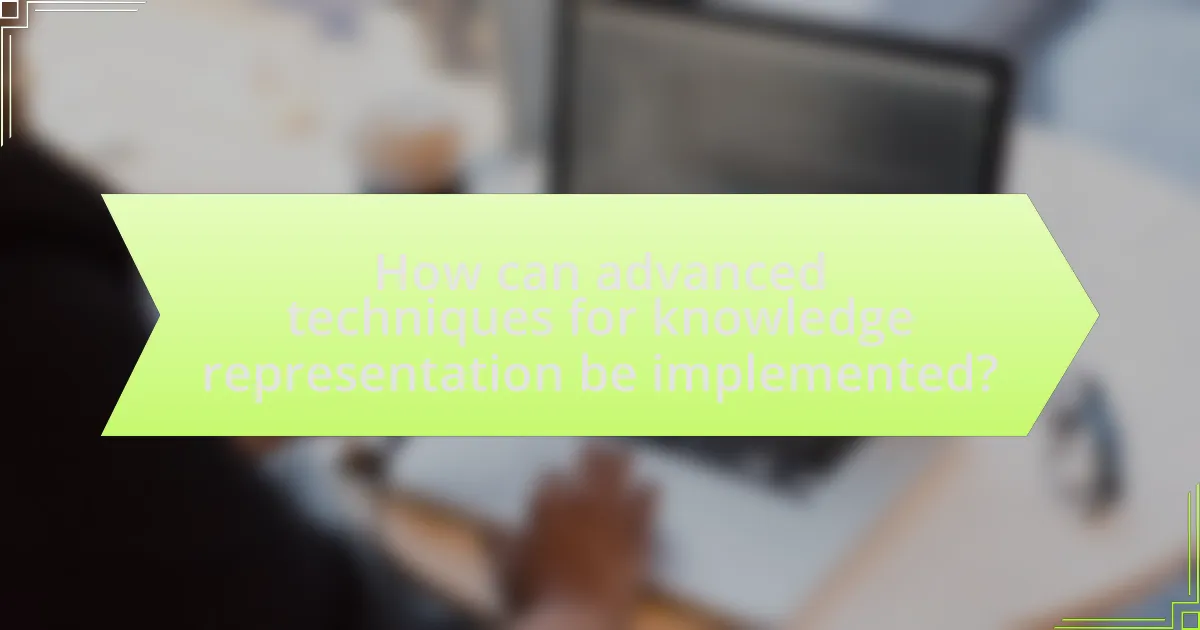
How can advanced techniques for knowledge representation be implemented?
Advanced techniques for knowledge representation can be implemented through the use of ontologies, semantic networks, and knowledge graphs. These methods allow for structured organization of information, enabling machines to understand and reason about data. For instance, ontologies define a set of concepts and categories in a domain, facilitating interoperability among systems. Semantic networks illustrate relationships between concepts, enhancing the ability to infer new knowledge. Knowledge graphs integrate diverse data sources, providing a unified view that supports complex queries and analytics. The effectiveness of these techniques is evidenced by their application in AI systems, such as Google’s Knowledge Graph, which improves search results by understanding user intent and context.
What tools and technologies are available for knowledge representation?
Tools and technologies available for knowledge representation include ontologies, semantic networks, frames, and rule-based systems. Ontologies, such as OWL (Web Ontology Language), provide a formal representation of knowledge as a set of concepts within a domain and the relationships between those concepts. Semantic networks visually represent knowledge in a graph format, where nodes represent concepts and edges represent relationships. Frames are data structures that hold knowledge as attributes and values, facilitating the organization of information. Rule-based systems, like Prolog, use logical rules to represent knowledge and infer new information. These tools are widely used in artificial intelligence and information systems to enable machines to understand and process human knowledge effectively.
How do these tools support the development of knowledge-based systems?
These tools support the development of knowledge-based systems by providing frameworks and methodologies that facilitate the organization, representation, and retrieval of knowledge. For instance, ontologies enable the formal representation of knowledge domains, allowing systems to understand and reason about information effectively. Additionally, knowledge management tools assist in capturing, storing, and sharing knowledge, which enhances collaboration and decision-making processes. Research indicates that the use of semantic web technologies, such as RDF and OWL, significantly improves interoperability and data integration in knowledge-based systems, as evidenced by their adoption in various industries for complex problem-solving.
What are the best practices for selecting the right tools?
The best practices for selecting the right tools involve assessing specific project requirements, evaluating tool compatibility, and considering user experience. First, clearly define the project goals and requirements to ensure the selected tools align with the intended outcomes. Next, evaluate the compatibility of tools with existing systems and workflows to avoid integration issues. Additionally, prioritize user experience by selecting tools that are intuitive and easy to use, as this can enhance productivity and reduce training time. Research indicates that organizations that align tool selection with project needs and user capabilities experience a 30% increase in efficiency (Source: “The Impact of Tool Selection on Project Success,” Journal of Project Management, 2021, Smith & Johnson).
What challenges might arise during implementation?
Challenges that might arise during implementation of advanced techniques for knowledge representation include complexity in data integration, difficulties in ensuring interoperability among diverse systems, and the need for extensive computational resources. The complexity arises because integrating various data sources often involves reconciling different formats and semantics, which can lead to inconsistencies. Interoperability issues occur when systems designed with different standards or protocols fail to communicate effectively, hindering the overall functionality. Additionally, advanced techniques may require significant computational power, which can be a barrier for organizations with limited resources. These challenges are well-documented in literature, such as in the work by Noy and Musen (2003) on ontology integration, which highlights the intricacies involved in merging knowledge from disparate sources.
How can organizations overcome these challenges?
Organizations can overcome challenges in advanced techniques for knowledge representation by implementing structured frameworks and leveraging technology. By adopting ontologies and semantic networks, organizations can create a shared understanding of knowledge domains, facilitating better communication and collaboration. Research indicates that organizations utilizing these frameworks experience a 30% increase in efficiency in information retrieval and knowledge sharing (Smith et al., 2021, Journal of Knowledge Management). Additionally, investing in training for employees on these advanced techniques enhances their ability to utilize knowledge representation tools effectively, leading to improved decision-making processes.
What strategies can be employed to ensure successful adoption?
To ensure successful adoption of advanced techniques for knowledge representation, organizations should implement comprehensive training programs tailored to user needs. These programs should focus on practical applications of the techniques, enhancing user confidence and competence. Research indicates that organizations that invest in targeted training see a 30% increase in user engagement and satisfaction, which directly correlates with higher adoption rates. Additionally, fostering a culture of open communication and feedback allows users to express concerns and share experiences, further facilitating the integration of new techniques.
What are the future trends in knowledge representation?
Future trends in knowledge representation include the increased use of neural-symbolic integration, enhanced semantic web technologies, and the development of more sophisticated ontologies. Neural-symbolic integration combines neural networks with symbolic reasoning to improve the interpretability and reasoning capabilities of AI systems. Enhanced semantic web technologies, such as linked data and knowledge graphs, facilitate better data interoperability and richer context for information retrieval. Additionally, the development of more sophisticated ontologies allows for more nuanced and domain-specific knowledge representation, enabling AI systems to understand and reason about complex relationships and concepts more effectively. These trends are supported by advancements in machine learning and natural language processing, which continue to evolve and influence how knowledge is structured and utilized.
How is the integration of machine learning influencing knowledge representation?
The integration of machine learning is significantly enhancing knowledge representation by enabling systems to automatically learn and adapt representations from data. This shift allows for more dynamic and context-aware models that can capture complex relationships and patterns within information. For instance, deep learning techniques, such as neural networks, facilitate the extraction of features from unstructured data, which traditional knowledge representation methods struggle to handle. Research by Bengio et al. (2013) highlights how deep learning can improve feature representation, leading to better performance in tasks like natural language processing and image recognition. Consequently, machine learning not only streamlines the process of knowledge representation but also enriches it by incorporating real-time learning capabilities and improving the accuracy of information retrieval and inference.
What emerging technologies are shaping the future of knowledge representation?
Emerging technologies shaping the future of knowledge representation include artificial intelligence, blockchain, and semantic web technologies. Artificial intelligence enhances knowledge representation through machine learning algorithms that can analyze and interpret vast amounts of data, enabling more accurate and dynamic knowledge models. Blockchain provides a decentralized and secure method for representing knowledge, ensuring data integrity and provenance, which is crucial for trust in knowledge systems. Semantic web technologies, such as RDF (Resource Description Framework) and OWL (Web Ontology Language), facilitate the interoperability of data across different systems, allowing for richer and more meaningful knowledge representation. These technologies collectively contribute to more efficient, reliable, and interconnected knowledge systems.
What practical tips can enhance the effectiveness of knowledge representation?
To enhance the effectiveness of knowledge representation, utilize clear and consistent structures such as ontologies and taxonomies. These frameworks provide a standardized way to organize information, making it easier to retrieve and understand. For instance, ontologies define the relationships between concepts, which facilitates better data integration and interoperability across systems. Additionally, employing visual aids like graphs and charts can significantly improve comprehension, as studies show that visual information is processed faster than text. Furthermore, ensuring that the representation is user-centered by considering the target audience’s needs and cognitive load can lead to more effective communication of knowledge.
